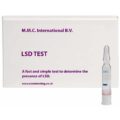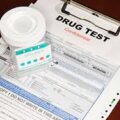Substance Abuse Testing
also known as drug screening involves the use of specialized techniques, kits, machines and procedures for the detection of one or more illegal and/or prescribed substances in the urine, blood, saliva, hair, or sweat. Drug abuse screening usually involves an initial screening test followed by a second test that identifies and/or confirms the presence of a drug or drugs. In general, testing detects substances not usually found in the human body, with the exception of certain hormones and steroids measured as part of sports testing.
The cutoff limits are set in accordance with Mandatory Guidelines for Federal Workplace Drug Testing Programs that were developed by SAMHSA (The Substance Abuse and Mental Health Services Administration) a branch of the U.S. Department of Health and Human Services.
What is Kratom?
Kratom (also known as Mitragyna speciosa) is a tree from Indonesia whose leaves produce a psychoactive effect. The leaf of the kratom tree is known to produce a full spectrum of typical opioid effects which can range from stimulation to sedation, and even both in some cases. As a recreational drug, the leaves are chewed or drank as a tea to elevate mood (as a euphoriant) and enhance physical endurance. Kratom contains a chemical called mitragynine. Mitragynine works like opioid drugs such as codeine and morphine to relieve pain.
Short-Term Effects Of Kratom Use
Because of the unique mix of chemicals in kratom, the short-term effects of the drug are complex and variable. The balance between stimulant-like and opiate-like effects depends on the dose taken, and different users have reported significantly different experiences with the drug even when taking the same dose.
Kratom’s Effects At Low Doses
At a low dose (1-5 g) of kratom, stimulant-like effects predominate. These are felt within 10 minutes and last for 60 to 90 minutes. While reports by users indicate that most people find these effects pleasant, some users experience an uncomfortable sense of anxiety and agitation. The primary stimulant-like effects of kratom are similar to amphetamine, though less intense, and include:
- Increased energy and alertness.
- Decreased appetite.
- Increased sociability.
- Heightened libido.
Kratom’s Effects At Moderate To High Doses
Moderate to high doses (5-15 g) of kratom have primarily opioid-like effects that last for several hours. The euphoric “high” induced by the drug is reportedly less intense than other opioid drugs, and some users describe the experience as unpleasant, or dysphoric. Other opiate-like effects include:
- Analgesia (pain reduction).
- Calm, dreamlike mental state.
- Cough suppression.
- Reduction in symptoms of opioid withdrawal.
Doses of kratom greater that 15 g have effects similar to high doses of opioids, including extreme sedation and a loss of consciousness in some cases.
Side Effects
There are several side effects associated with kratom use that range in severity from inconvenient to dangerous. Like the sought-after effects listed above, it’s side effects are dependent on the dose taken and are similar to those found both for stimulant drugs and opiates, including:
• Pupillary constriction (tiny pupils).
• Facial flushing (blushing).
• Tremors or loss of motor coordination.
• Constipation.
• Sweating.
• Dizziness.
• Nausea and vomiting.
• Itching.
Serious toxic effects appear to be rare among reports by users and healthcare providers, but there is little information available to estimate the true danger of kratom use. Most serious toxic reactions have been associated with high doses of kratom (>15 g) and have been characterized by seizures.
The hazards of kratom use appear to be especially high in the case of “Krypton,” which is an herbal product marketed as an especially potent form of kratom. Krypton is actually a combination of kratom and O-desmethyltramadol, a chemical otherwise encountered as a metabolite of the pain medication tramadol (Ultram). This combination increases the depressive effects on the central nervous system, and Krypton use has been blamed for several deaths in Sweden.
Long-Term Effects
Judging by research done on chronic, high-dose kratom users in Thailand, there are several unusual long-term effects of this drug such as:
- Hyperpigmentation, or darkening of facial skin.
- Anorexia and weight loss.
- Psychosis
However, the available evidence does not suggest that long-term kratom use damages organs or other parts of the body. People often wonder how long kratom stays in the system when they are considering stopping their kratom use. Someone who is dependent on kratom and wants to stop using the substance may be worried about the withdrawal effects and when they will begin. Also, someone might wonder how long kratom stays in their system if they are going to be drug tested, although kratom doesn’t show up in many traditional drug tests.
Since there hasn’t been a lot of research done on kratom, the half-life isn’t completely understood. It’s only been studied in-depth in animals. However, based on the research conducted thus far, it’s believed that the primary alkaloid found in kratom, mitragynine, has a half-life of around 23.24 hours.
Based on that information, it would take around a full day for someone to eliminate 50% of the kratom in their body. It would take just over five days for kratom to be fully cleared from the system, based on this half-life information.
Based on current research, the fastest half-life of kratom alkaloids could be just over two hours, which would put full elimination at around a half day. However, on the slower end of the half-life spectrum, it could take around nine days for all of the kratom to be eliminated from a person’s system.
There is evidence suggesting that someone who has used kratom less frequently or uses lower doses would eliminate the substance more quickly than long-term or habitual users.
Does Kratom Show Up On A Drug Test?
The effects of Kratom usually begin around 10 to 15 minutes after using the drug. The effects of a small dose of kratom can last for around two hours, and with higher doses, effects may last as long as eight hours. Kratom urine testing kits can quantitatively detect presence of Mitragyninen the active ingredient in Kratom using advanced liquid chromatography ( tandem mass spectrometry (LC-MS/MS) to provide definitive test results. However, kratom does not show up on many standard drug tests like the Substance Abuse and Mental Health Services Administration SAMHSA-5, but there are some kratom alkaloids that can be detectable on certain drug tests, such as urine or blood tests.
Can Kratom Make You Fail a Drug Test?
Alabama, Arkansas, Indiana, Tennessee, Vermont, Wisconsin and the District of Columbia have all banned kratom This means that you can fail a drug test for kratom if you use the plant and you are tested in this places for the presence of Mitragyninen.
Safety of Kratom
- Although people may use kratom to try to overcome opioid addiction, kratom itself may be addictive. People may build up a tolerance to it (they may need higher doses to achieve the same effect), and long-term users may experience withdrawal symptoms if they stop using it.
- Studies in experimental animals suggest that high doses of kratom may be less likely than high doses of opioids to be fatal. However, some deaths in people have been linked to kratom. Typically, they have involved the use of kratom in combination with opioids or various prescription or over-the-counter drugs.
- A variety of side effects of kratom have been reported. They include anxiety, irritability, and increased aggression, which may be related to the drug’s stimulant effects; and sedation, nausea, constipation, and itching, which may be related to its opioid-like effects. Increased pigmentation of the cheeks, tremor, loss of appetite, weight loss, and psychosis have been seen in long-term kratom users. Seizures have been reported in users of high doses of kratom. Read: How Does Smoking Kratom Affects You?





